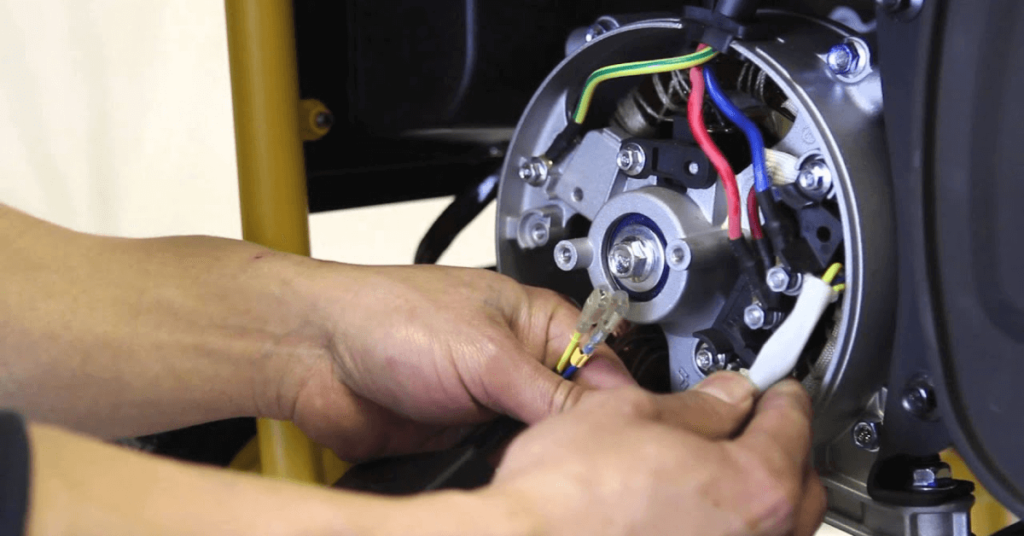Electric generators are essential for providing backup power during times of power outages or when an independent power source is needed. Why Electric Generators Need Proper Voltage Regulation. However, to ensure their optimal performance and longevity, proper voltage regulation is crucial.
Voltage regulation is the process of stabilizing the voltage output of an electric generator to ensure it remains within a certain range. In this article, we will discuss why proper voltage regulation is crucial for electric generators, the causes and effects of voltage fluctuations, and the different types of voltage regulation methods.

Understanding Voltage Regulation
Voltage regulation is the process of maintaining a constant voltage output for an electric generator, regardless of changes in the load demand or other external factors. Proper voltage regulation is important for maintaining the quality of power output, ensuring the safety of equipment and personnel, and prolonging the lifespan of the generator.
There are different types of voltage regulation methods, including Automatic Voltage Regulators (AVRs), Electronic Voltage Regulators (EVRs), and Transformer Tap Changing.
AVRs are commonly used in generators and regulate voltage by varying the excitation current of the generator’s alternator. EVRs, on the other hand, use electronic circuits to regulate voltage, while transformer tap changing is a method that involves changing the voltage output by adjusting the transformer taps.
Causes and Effects Of Voltage Fluctuations
Voltage fluctuations are changes in the voltage output of an electric generator caused by various factors, including changes in the load demand, faults in the system, and environmental factors such as temperature and humidity. These fluctuations can cause significant problems, including reduced efficiency, increased wear and tear on equipment, and safety hazards.
One of the effects of voltage fluctuations is reduced efficiency, which can lead to higher operating costs and increased downtime. Voltage fluctuations can also cause increased wear and tear on electrical equipment, leading to a shorter lifespan for the equipment. Additionally, voltage fluctuations can cause safety hazards, such as electrical shocks and fires, which can be hazardous to personnel and equipment.
How Voltage Regulation Works
Voltage regulation works by stabilizing the voltage output of an electric generator. Automatic voltage regulators work by varying the excitation current of the generator’s alternator, while electronic voltage regulators use electronic circuits to regulate voltage. Transformer tap changing works by adjusting the transformer taps to change the voltage output.
Proper voltage regulation is essential for maintaining the quality of power output, ensuring the safety of personnel and equipment, and prolonging the lifespan of the generator. The choice of voltage regulation method depends on several factors, including the type of generator, load demand, environmental factors, and budget.
Importance Of Proper Voltage Regulation For Electric Generators
Proper voltage regulation is crucial for electric generators to ensure they operate efficiently, safely, and with a long lifespan. The benefits of proper voltage regulation include increased efficiency, longer lifespan of equipment, improved safety, reduced downtime, and cost savings.
Common Voltage Regulation Issues For Electric Generators
Common issues that arise from improper voltage regulation include voltage fluctuations, overvoltage, and Undervoltage. These issues can cause significant problems, including reduced efficiency, increased wear and tear on equipment, and safety hazards.
Factors To Consider When Choosing A Voltage Regulator
When choosing a voltage regulator, several factors must be considered, including the type of generator, load demand, environmental factors, and budget. The choice of voltage regulator can significantly affect the performance and longevity of the generator.
Best Practices For Voltage Regulation
Following best practices for voltage regulation is essential for ensuring the optimal performance and longevity of the generator. Best practices include regular maintenance, proper installation, proper operation, and monitoring and testing. Regular maintenance can help prevent issues from arising and catch any problems early on.
Proper installation is also critical to ensure the voltage regulator functions correctly. The proper operation involves following proper procedures and guidelines, while monitoring and testing help ensure the voltage regulator is functioning correctly.
Testing Voltage Regulation
Testing voltage regulation is an important aspect of ensuring the proper operation of the generator. Testing involves measuring the voltage output of the generator and comparing it to the desired range. Regular testing can help identify issues early on and prevent them from causing significant problems.
Choosing The Right Voltage Regulation Solution For Your Electric Generator
When choosing the right voltage regulation solution for your electric generator, several factors must be considered, including the type of generator, load demand, environmental factors, and budget. A comparison of different voltage regulation solutions can help you make an informed decision.
How To Install A Voltage Regulator
To ensure that the voltage regulator operates correctly, it is crucial to install it properly. The installation process involves several essential steps, which include determining the suitable location for the regulator, connecting it to the generator, and making sure that the wiring and grounding are done correctly.
These steps are critical in ensuring that the voltage regulator functions as intended and that the generator operates efficiently and safely. Therefore, it is essential to follow the manufacturer’s instructions carefully during the installation process to avoid any issues and ensure the smooth operation of the voltage regulator.
Troubleshooting Voltage Regulation Issues
When problems with voltage regulation occur, it is crucial to identify the underlying cause and take the appropriate actions to rectify the issue.
To troubleshoot this problem, one must follow a series of steps, such as identifying the issue at hand, determining the root cause, and taking the necessary measures to resolve it.
How To Maintain Voltage Regulators
To ensure voltage regulators operate efficiently and last a long time, it is crucial to conduct proper maintenance. By regularly maintaining voltage regulators, potential issues can be prevented and any problems that do arise can be caught early. Maintenance typically involves cleaning, inspecting, and testing the regulators.
Impact Of Improper Voltage Regulation On Electrical Equipment
Maintaining proper voltage regulation is crucial for electrical equipment as it can greatly affect its performance and safety. When voltage is not regulated correctly, the equipment may experience reduced efficiency, increased wear and tear, and potentially dangerous safety hazards.
Therefore, it is essential to ensure proper voltage regulation to prevent these problems and ensure that the equipment operates at its best and lasts for a long time.
Importance Of Safety In Voltage Regulation
Working with voltage regulators can be dangerous and poses potential risks to the individuals involved. Therefore, it is important to take necessary safety measures when handling voltage regulators.
Adequate training and certification are crucial to ensure that personnel have a clear understanding of the hazards associated with this equipment and know how to operate it safely. By following proper safety guidelines, individuals can prevent accidents and ensure a secure working environment.
The Future Of Voltage Regulation For Electric Generators
The future of voltage regulation for electric generators is exciting, with emerging trends in technology that promise to improve efficiency and reduce costs.
These trends include the development of smart grid technology, improved energy storage solutions, and more advanced voltage regulation methods.
Additional Resources
For readers who want to learn more about voltage regulation for electric generators, the following resources may be helpful:
- “Electric Generators Handbook: Two-Volume Set” by Ion Boldea and Syed A. Nasar
- “Electric Power Generation, Transmission, and Distribution” by Leonard L. Grigsby
- “IEEE Guide for Voltage Regulator Applications” by the Institute of Electrical and Electronics Engineers
- “Best Practices for Voltage Regulation of Electric Power Generators” by the Electric Power Research Institute
In conclusion, proper voltage regulation is essential for ensuring the optimal performance and longevity of electric generators. Understanding the causes and effects of voltage fluctuations, the different types of voltage regulation methods, and best practices for voltage regulation can help ensure the proper operation of the generator.
Regular maintenance, monitoring, and testing can help prevent issues from arising and catch any problems early on. Proper safety precautions and training are also essential to ensure the safety of personnel and equipment. By following these guidelines, electric generators can operate efficiently, safely, and with a long lifespan.
FAQs Why Electric Generators Need Proper Voltage Regulation
What is voltage regulation?
Voltage regulation is the process of stabilizing the voltage output of an electric generator to ensure it remains within a certain range.
Why is voltage regulation important for electric generators?
Proper voltage regulation is important for maintaining the quality of power output, ensuring the safety of equipment and personnel, and prolonging the lifespan of the generator.
What are the different types of voltage regulation?
The different types of voltage regulation include Automatic Voltage Regulators (AVRs), Electronic Voltage Regulators (EVRs), and Transformer Tap Changing.
What are the common causes of voltage fluctuations?
The common causes of voltage fluctuations include changes in the load demand, faults in the system, and environmental factors such as temperature and humidity.
What are the best practices for voltage regulation?
The best practices for voltage regulation include regular maintenance, proper installation, proper operation, and monitoring and testing.
Conclusion
In summary, maintaining appropriate voltage regulation is critical for electric generators to function optimally, without compromising safety and durability. Being aware of the causes and impacts of voltage fluctuations, the various voltage regulation techniques available, and adopting effective voltage regulation practices can aid in ensuring the smooth functioning of the generator.
Additionally, routine upkeep, consistent monitoring, and frequent testing can prevent issues from occurring and identify potential problems in the early stages. Ensuring that safety protocols are followed and staff is trained accordingly is also crucial to safeguarding both the equipment and personnel.




